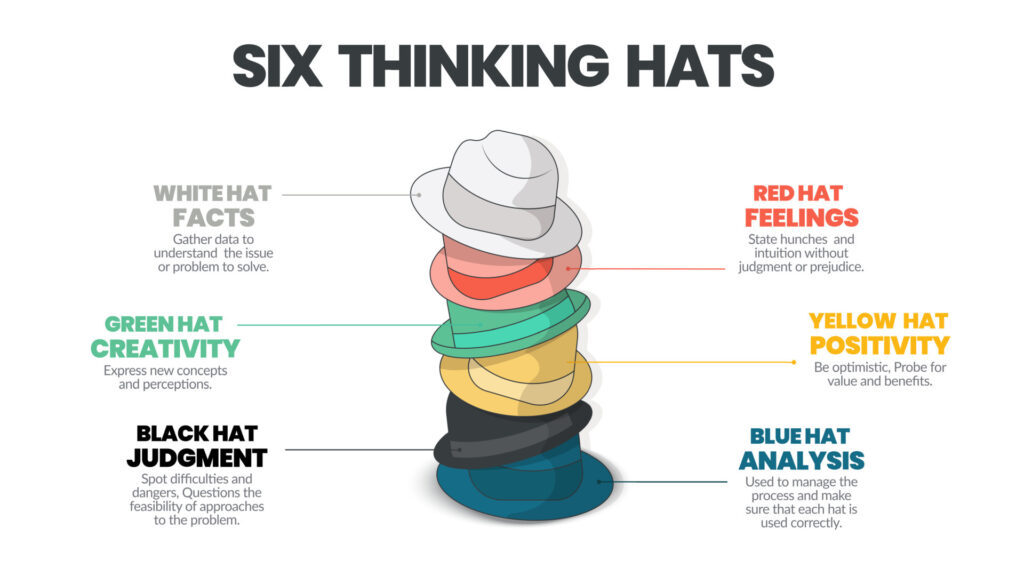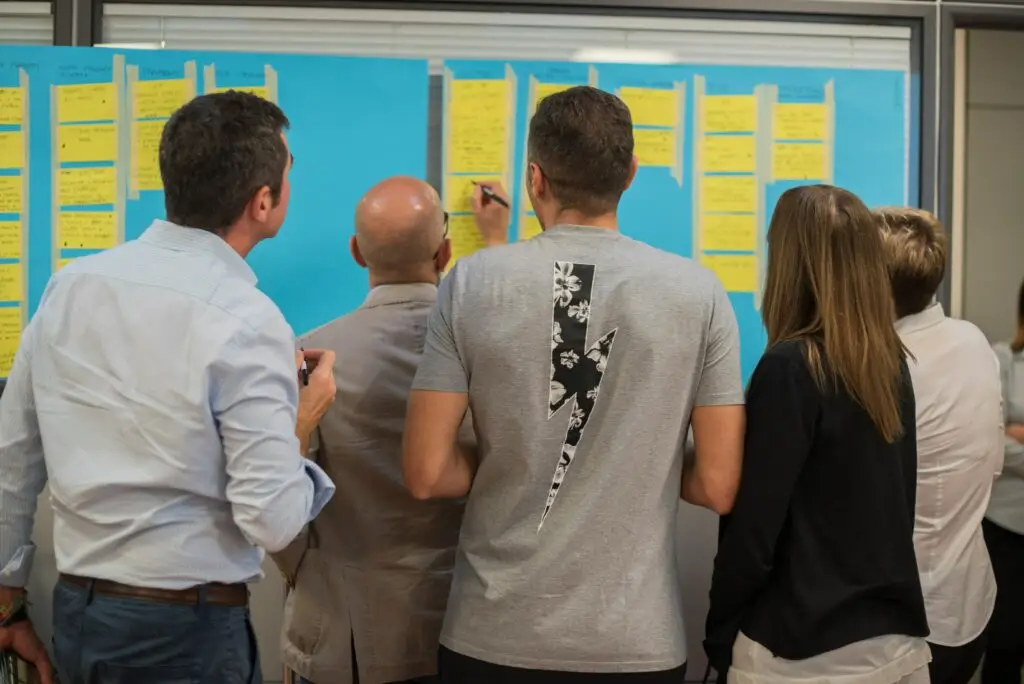In the dynamic landscape of business, effective decision-making is paramount to success. Yet, traditional methods often fall short in addressing the complexity and diversity of challenges faced by organisations. Enter the Six Thinking Hats, a powerful framework developed by Edward de Bono, designed to revolutionise the way teams approach problem-solving and decision-making. In this article, we delve into the intricacies of the Six Thinking Hats methodology, exploring its principles, applications, and the transformative impact it can have on organisational performance.

Understanding the Six Thinking Hats
The Six Thinking Hats framework offers a structured approach to decision-making, enabling teams to explore problems from multiple perspectives. Each “hat” represents a different mode of thinking, guiding individuals to adopt specific roles and viewpoints during discussions. These hats are:
- White Hat: Focused on facts and information, the White Hat encourages objective analysis and data-driven decision-making.
- Red Hat: Embracing intuition and emotion, the Red Hat allows individuals to express feelings, hunches, and gut reactions without needing to justify them.
- Black Hat: Symbolising critical thinking, the Black Hat facilitates the identification of risks, weaknesses, and potential pitfalls in proposed solutions.
- Yellow Hat: Promoting optimism and positivity, the Yellow Hat encourages the exploration of benefits, opportunities, and potential strengths.
- Green Hat: Associated with creativity and innovation, the Green Hat encourages lateral thinking, brainstorming, and the generation of alternative ideas.
- Blue Hat: Serving as the facilitator, the Blue Hat oversees the thinking process, sets objectives, and manages the discussion flow.
By donning each hat metaphorically, teams can systematically explore different aspects of a problem, fostering comprehensive analysis and informed decision-making.



Applications of the Six Thinking Hats in Business
Now, let’s explore how companies can harness the power of the Six Thinking Hats to enhance their performance across various domains:
- Strategy Development: When devising strategic plans, organisations often encounter uncertainties and conflicting perspectives. By applying the Six Thinking Hats, teams can systematically evaluate different strategic options. For example, the White Hat encourages a thorough analysis of market data and competitor trends, while the Yellow Hat helps identify potential growth opportunities. Meanwhile, the Black Hat prompts teams to assess the risks and drawbacks associated with each strategy, ensuring a balanced approach.
- Product Innovation: In the competitive landscape of product development, creativity and market relevance are essential. By incorporating the Green Hat approach, companies can foster innovation and brainstorm new product ideas. Cross-functional teams can leverage diverse perspectives, with the Red Hat allowing for the expression of intuitive insights, and the Yellow Hat highlighting the potential benefits and market appeal of innovative concepts.
- Problem-Solving: When confronted with complex problems or challenges, traditional brainstorming sessions often yield limited results. The Six Thinking Hats offer a structured framework for problem-solving, encouraging teams to explore multiple angles. For instance, during a crisis management scenario, the Black Hat can help identify root causes and potential consequences, while the Green Hat facilitates the generation of creative solutions. By systematically switching between hats, teams can arrive at holistic and effective solutions.
- Team Collaboration: Effective teamwork relies on clear communication, mutual respect, and collaborative decision-making. The Six Thinking Hats provide a common language and framework for collaboration, fostering constructive dialogue and idea exchange. By encouraging each team member to contribute from their unique perspective, the Blue Hat facilitator can ensure that discussions remain focused and productive, leading to consensus-driven outcomes.
- Risk Management: In an era of rapid change and uncertainty, businesses must proactively assess and mitigate risks to safeguard their operations. The Black Hat approach within the Six Thinking Hats framework enables organisations to conduct thorough risk assessments. Teams can identify potential vulnerabilities, anticipate worst-case scenarios, and develop contingency plans. By systematically addressing risks from different angles, companies can enhance their resilience and adaptability in the face of unforeseen challenges.
- Customer Experience Enhancement: Understanding and meeting customer needs is paramount to business success. The Six Thinking Hats methodology can be applied to enhance the customer experience by examining products, services, and processes from various perspectives. For instance, during a service design workshop, the Yellow Hat can help identify positive aspects of the customer journey, while the Black Hat prompts teams to address pain points and areas for improvement. By adopting a customer-centric approach, companies can drive innovation and differentiate themselves in the marketplace.
Case Study: Implementing Six Thinking Hats at XYZ Corporation
To illustrate the practical application of the Six Thinking Hats, let’s consider the case of XYZ Corporation, a multinational conglomerate seeking to streamline its product development process. Facing increased competition and shifting consumer preferences, XYZ Corporation aimed to accelerate innovation while mitigating risks.
XYZ Corporation implemented the Six Thinking Hats framework across its product development teams, facilitating cross-functional collaboration and idea generation. During brainstorming sessions, team members adopted different hats to explore product concepts from diverse perspectives. The Green Hat encouraged creative thinking and ideation, while the Black Hat prompted teams to critically evaluate technical feasibility and market viability.
As a result of implementing the Six Thinking Hats methodology, XYZ Corporation experienced several tangible benefits:
- Increased Innovation: By fostering a culture of creativity and idea sharing, XYZ Corporation saw a surge in innovative product concepts and design improvements. The Green Hat approach facilitated out-of-the-box thinking, leading to breakthrough solutions and novel approaches to product development.
- Enhanced Decision-Making: The structured nature of the Six Thinking Hats framework enabled XYZ Corporation to make more informed decisions. By systematically evaluating options from multiple angles, teams could assess risks, opportunities, and potential outcomes with greater clarity and confidence.
- Improved Collaboration: Cross-functional teams at XYZ Corporation reported improved collaboration and communication as a result of adopting the Six Thinking Hats methodology. The common language and structured approach provided a framework for constructive dialogue and idea exchange, fostering a sense of shared purpose and mutual respect among team members.
- Faster Time-to-Market: With streamlined decision-making processes and accelerated innovation cycles, XYZ Corporation was able to bring new products to market more quickly and efficiently. The systematic approach of the Six Thinking Hats enabled teams to overcome obstacles and address challenges in a timely manner, ensuring that project timelines were met and deadlines were achieved.
Effective decision-making is essential for success. The Six Thinking Hats methodology offers a structured approach to problem-solving and decision-making, empowering teams to explore challenges from multiple perspectives. By adopting this innovative framework, companies can enhance their performance, drive innovation, and achieve sustainable growth in an increasingly competitive landscape. Embracing the Six Thinking Hats philosophy enables organisations to unlock new opportunities, overcome obstacles, and navigate complexities with confidence and clarity.

